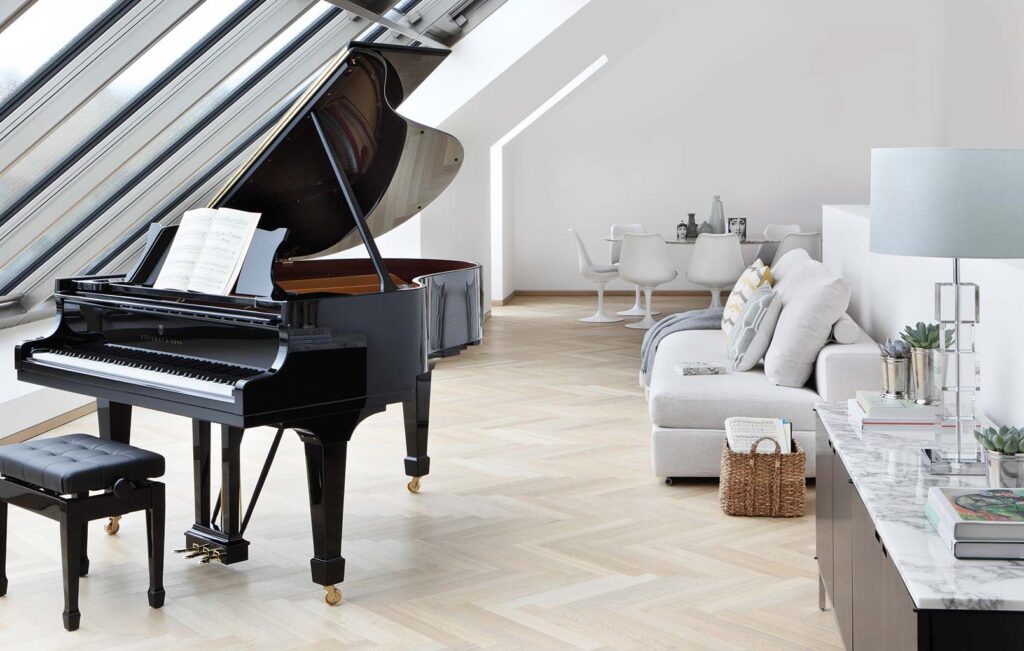Moving a piano can be a daunting task, especially if you are doing it for the first time. There are various methods and techniques that people use to move pianos, but one question that often comes to mind is whether a piano can be moved on its end. After all, it seems like an easy way to transport such a heavy instrument.
The short answer is no, you cannot move a piano on its end. Pianos are designed to be moved and played in an upright position only. Tilting the piano on its side or end can cause serious damage to its delicate internal components and may also result in injury.
In this article, we will discuss why moving a piano on its end is not recommended and explore alternative methods for safely transporting a piano. We will also provide some tips and precautions to keep in mind when moving a piano to ensure that it reaches its destination unscathed. So, read on to learn more about the dos and don’ts of moving a piano.
Why You Should Not Move A Piano On Its End
As mentioned earlier, pianos are designed to be moved and played in an upright position. This is because the internal components of a piano, such as the strings and hammers, are delicately balanced to produce the best sound quality. Tilting or moving a piano on its end can disrupt this balance and cause damage to these fragile parts.
Moreover, pianos are heavy instruments, with even smaller models weighing several hundred pounds. Moving them on their end can put a strain on the instrument’s structure and lead to cracks, dents, or other types of damage. Not to mention, it can also be dangerous for the people involved in moving the piano.
Alternative Methods for Moving a Piano
Here are some alternative methods that you can use to move a piano safely and efficiently:
Slide the piano:
One of the most common methods for moving a piano is sliding it. This method involves placing blankets or furniture sliders under the piano’s legs and carefully pushing or pulling it to its destination.
However, this method requires significant physical strength and coordination to ensure that the piano does not tip over or get damaged. It is also recommended to have at least four people helping with the move to distribute the weight and make it easier to control the piano’s movement.
Use a Professional Piano Moving Company
If you are not comfortable moving a piano on your own or do not have access to enough people to help, then hiring a professional piano moving company is your best bet. These companies have specialized equipment, such as piano dollies and straps, to safely move pianos without causing any damage.
Moreover, professional piano movers are trained and experienced in handling all types of pianos, from uprights to grand pianos. They also have insurance coverage for your peace of mind in case any accidents occur during the move.
Disassemble the Piano
Another option for moving a piano is to disassemble it first. This method is ideal if you are moving the piano over long distances or navigating through tight spaces, such as narrow doorways or staircases.
To disassemble a piano, start by removing the lid and wrapping it in protective material. Then, remove the pedals and legs from the body of the piano. Next, remove the keyslip (the long piece of wood above the keys) and carefully take out the keys. Finally, wrap each individual part in blankets or padding and secure them with tape.
Consider Professional Piano Tuning After the Move
No matter which method you choose, it is essential to have your piano tuned after it has been moved. The vibrations and jostling during transportation can cause the strings to go out of tune, affecting the sound quality of your instrument.
Therefore, it is best to get a professional piano tuner to tune your piano once it has reached its new location. This will ensure that your piano sounds just as beautiful as it did before the move.
Tips and Precautions for Moving a Piano
Here are some additional tips to keep in mind when moving a piano:
Clear the Pathways:
Before attempting to move a piano, make sure that the pathways and doorways are clear of any obstacles or clutter. This will prevent any accidents from occurring during the move and also make it easier to maneuver the piano.
Use Protective Covers:
Pianos have a delicate finish that can easily get scratched or damaged during transportation. To protect your piano’s exterior, wrap it in blankets, padding, or specialized piano covers.
Use Proper Lifting Techniques:
If you are moving a piano on your own, make sure to use proper lifting techniques to avoid injuring yourself. Bend your knees and keep your back straight while lifting the piano. Also, try to distribute the weight evenly among all individuals involved in the move.
Communicate Clearly:
Communication is key when moving a piano, especially if there are multiple people involved. Make sure to establish clear communication channels and communicate any changes or adjustments in movement carefully.
Plan Ahead:
Moving a piano is a big undertaking, so it is essential to plan ahead and give yourself enough time to complete the task. Rushing can lead to accidents or mistakes that could damage your piano.
How to Maintain Your Piano’s Health in move
Moving a piano can be stressful and physically demanding, but it is also essential to consider your piano’s health during the move. Here are some tips on how to maintain your piano’s health during transportation:
Keep Your Piano in a Stable Position:
While transporting your piano, make sure that it remains in a stable position at all times. Avoid bouncing or jostling the piano, as this can cause damage to its internal components.
Protect It from Extreme Temperatures:
Pianos are sensitive to extreme temperatures. Therefore, it is crucial to keep your baby grand pianos away from direct sunlight or cold drafts during the move. Extreme temperature changes can cause the wood and other materials in your piano to expand or contract, leading to cracks and other types of damage.
Avoid Humidity and Moisture:
Similar to extreme temperatures, humidity and moisture can also cause damage to professional piano mover. Try to keep your piano in a dry environment during the move. If you are moving the piano over long distances, consider investing in a humidity control system to maintain a consistent level of humidity.
Avoid Laying the Piano on Its Side:
While it may seem easier to lay a piano on its side during transportation, this can actually cause harm to your instrument. The internal components of a piano are carefully balanced, and laying it on its side can disrupt this balance, leading to potential damage.
Inspect Your Piano After the Move:
Once your piano has reached its new location, take some time to inspect it for any signs of damage or issues. Check the keys and pedals, as well as the internal components, to ensure that everything is in working order.
Common mistake to avoid when moving a piano
Moving a piano is a delicate process, and there are many mistakes that can be made if you are not careful. Here are some common mistakes to avoid when moving a piano:
Not Securing the Lid Properly:
The lid of a piano is an essential part that protects the keys and internal components. If it is not secured properly during transportation, it can lead to damage or even falling off completely. Make sure to secure the lid with proper padding and straps.
Not Using Proper Equipment:
Trying to move a piano without the right equipment, such as dollies or straps, can result in serious damage or injury. It is crucial to use specialized equipment designed for piano pianos moving to ensure a safe and successful move.
Rushing the Process:
As mentioned before, rushing can lead to mistakes and accidents that could harm your piano. Take your time and plan ahead to ensure a smooth and safe move for your instrument.
Not Hiring Professionals:
Moving a piano is not a task that should be taken lightly. It is best to hire professional movers who have experience in handling pianos to avoid any potential damage to your instrument.
Not Protecting the Piano Properly:
Pianos are delicate and require proper protection during transportation. Failing to adequately wrap and secure your piano can result in scratches, dents, or other damage.
FAQs
1. Can you use a piano dolly to move an upright piano, and what precautions should be taken when placing the piano on its end?
Explore the possibility of using a piano dolly to move an upright pianos and understand the precautions necessary when placing the piano on its end. Learn about the considerations for navigating stairs and using a moving truck, ensuring a secure and damage-free piano transport.
2. Is it advisable to use a piano dolly to move a baby grand piano?
Understand the feasibility of using a piano dolly to move a baby grand piano and explore the challenges and precautions involved in placing a baby grand piano on its end. Learn about the considerations for moving the piano downstairs or upstairs, ensuring the safety and integrity of the instrument during the process.
Can a piano dolly be used for moving a spinet piano?
Explore the suitability of using a piano dolly for moving a spinet piano and understand the steps and precautions needed when placing a spinet piano on its end. Learn about the considerations when using a piano board or a moving truck to transport the spinet piano, ensuring a smooth and secure relocation process.
Conclusion:
Moving a piano can be a challenging and nerve-wracking task, but with the right preparation and precautions, it can be done safely and successfully. Remember to clear pathways, use protective covers, communicate clearly, plan ahead, and take care of your piano during transportation to ensure its health and well-being. Avoid common mistakes such as not securing the lid properly or rushing the process, and consider hiring professionals for a stress-free move.
By following these tips, you can ensure that your piano will reach its new location unharmed and ready to produce beautiful music once again. So, if you are planning on moving your piano soon, keep these tips in mind and make the process as smooth as possible.






